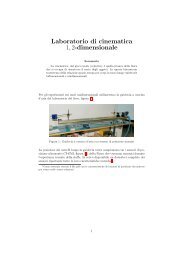Newton's law of cooling revisited - Cartan
Newton's law of cooling revisited - Cartan
Newton's law of cooling revisited - Cartan
You also want an ePaper? Increase the reach of your titles
YUMPU automatically turns print PDFs into web optimized ePapers that Google loves.
1082 M Vollmer<br />
Figure 17. Cooling <strong>of</strong> the halogen light bulb. Deviations between measured temperatures and<br />
expectations from Newton’s <strong>law</strong> occur for �T > 100 K as indicated by the straight line (left).<br />
The data could be fitted by a double exponential function (solid line, right). For the smallest<br />
temperatures, the signal (dots) is very noisy. This is due to the fact that the temperature range<br />
<strong>of</strong> the camera was fixed to 80–500 K during the measurement, hence data below 80 K must be<br />
considered with care.<br />
For the measurement in figure 16, the halogen light bulb was powered until an equilibrium<br />
temperature was reached, then, the power was turned <strong>of</strong>f and the <strong>cooling</strong> curve was recorded.<br />
Compared to the metal cubes, the <strong>cooling</strong> <strong>of</strong> the light bulb occurs much faster due to the small<br />
amount <strong>of</strong> stored thermal energy in the mass <strong>of</strong> the light bulb. The smaller the system, the<br />
smaller the respective time constants (see [5] and figure 13).<br />
Experimental results for the <strong>cooling</strong> <strong>of</strong> the halogen light bulb (figure 17) are nicely<br />
represented by a simple exponential function for small �T values, but deviations occur for<br />
larger �T values. Theoretically—in comparison to the cubes—we expect larger natural<br />
convection heat-transfer coefficients due to the larger temperature difference. Therefore,<br />
convection will start to dominate much earlier during the <strong>cooling</strong> process. Therefore, Newton’s<br />
<strong>law</strong> seems to be fulfilled for higher temperature differences <strong>of</strong> up to about 100 K. However,<br />
deviations for larger temperatures are clearly observed.<br />
Similar to figure 7, the <strong>cooling</strong> curve can be approximated by a higher order exponential<br />
function. Since deviations are less pronounced than in the model for figure 7, a second-order<br />
fit with time constants <strong>of</strong> 16.7 s (initial part, amplitude 37.7) and 77.3 s (slower decrease with<br />
amplitude 259.3) provides already reasonable results.<br />
7. Summary and conclusions<br />
Nonlinear radiative heat transfer in <strong>cooling</strong> processes <strong>of</strong> objects with small Biot numbers<br />
does lead to systematic deviations from simple exponential <strong>cooling</strong> curves. Three related<br />
questions were investigated theoretically as well as experimentally: (i) what is the magnitude<br />
<strong>of</strong> deviations? (ii) is it possible to define a range <strong>of</strong> validity for Newton’s <strong>law</strong> <strong>of</strong> <strong>cooling</strong>? and<br />
(iii) can these deviations be easily observed experimentally?<br />
The first and second questions are connected to each other. Theoretical studies which<br />
assumed a constant convective heat transfer revealed that the magnitude <strong>of</strong> the deviations<br />
does sensitively depend on the ratio between convective and radiative heat-transfer rates. If<br />
radiation dominates, deviations from Newton’s <strong>law</strong> become obvious already at low temperature<br />
differences, <strong>of</strong> say 30 K. If, however, convection dominates over the radiative heat transfer,




